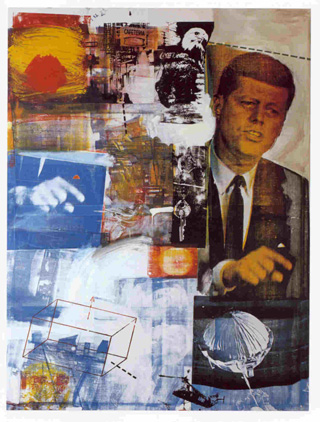Post-modernism juxtaposed modernism completely by questioning everything with uncertainty. The movement showed a longing to understand by deconstructing ideas whereas modernism provided solid answers.

Image 1
Weingart uses a combination of type and layering to create visual communications. The use of tone builds up depth and contrast within the image. This is complimented by the positioning of type which looks purposefully revealed. The fragmented image creates a sense of incoherence which effectively makes the audience study the work’s entirety. “The way I worked, and the action of my scissor mirrored an inner reality: …contradictory, … erratic- in short, quick snips.” (1) (Weingart,1960’s) I like this process and use collage in my own practice using layers to hide and reveal which makes the revealed more powerful.

Image 2
To me, Rauschenberg’s image embodies multiplicity. JFK died during the creation of this work which meant the meaning suddenly changed. As an illustrator, I like the way emotions are created through a visual journey. The contrasting colour and layering, like Weingart’s work, shows conflict which makes the audience doubt how they feel. The warm colours suggest a celebration of Kennedy as an individual, yet the cold blue hand infers death and failure as JFK didn’t manage to fulfil many policies (2).

Image 3
Drucker’s illustrative type creates confusion. It is only by deconstructing, that we can understand the text. I feel this is a clever way and successfully engages the audience as it traps “the eye in a field of letters which make a complex object on the page” (3) (Drucker, 1996) I like the idea of deconstructing words to become only letters as a metaphor of how easily manipulated language can be and how words hold so much power over emotions and major events.
Post-modernism opened art to multiple interpretations by asking different questions, making it successful because individuals develop personal responses.
References:
(3)- Johanna Drucker. (1996). The word made flesh. Available: https://www.granarybooks.com/book/43/. Last accessed 2/12/17.
(2)- Unknown. (unknown). Robert Rauschenberg, buffalo II, (1964), mixed. Available: https://www.thinglink.com/scene/522501012372586496#. Last accessed 2/12/17.
(1) Weingart, Wolfgang, Typography / Wolfgang Weingart (Baden, Switzerland : Lars Müller ; New York, NY : Distribution USA and Canada, Princeton Architectural Press, c2000), 355. Last accessed 2/12/17
Images:
(3)- Johanna Drucker. (1989). The word made flesh. Available: https://i.pinimg.com/originals/4a/fa/27/4afa270e19ca6543bb477eba66f0f072.jpg. Last accessed 2/12/17.
(2)- Robert Rauschenberg. (1964). buffalo II. Available: http://hyperallergic.com/wp-content/uploads/2013/04/Rauschenberg-320.jpg. Last accessed 2/12/17.
(1)- Wolfgang Weingart. (1960s). Poster page. Available: http://2.bp.blogspot.com/-DALgAs8uS6k/USIKJMSyKuI/AAAAAAAAAM4/4YQlA0k83hs/s1600/Wolfgang+Weingart%255B1%255D.jpg. Last accessed 2/12/17.
